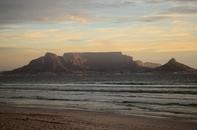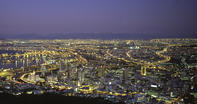A Former Ship's Surgeon
After the positive testimonials from the crew of the Niewe Harlem, the VOC - Vereenigde Landsche Ge-Oktroyeerde Oostindische Compagnie - was prodded into action to secure a refreshment station in the Cape. So, in 1652 - one hundred and fifty years after Bartolomeu Dias rounded the Cape - a former ship’s surgeon sailed into Table Bay.

His name was Jan Anthoniszoon van Riebeeck, and he was charged with the task of establishing a refreshment station for the VOC under the main face of Table Mountain. It was to be the first permanent European settlement in South Africa. Van Riebeeck was born in Culemborg in 1619.
He joined the VOC and worked his way through the ranks, until he was appointed commander of the newly proposed Cape Settlement in 1651. Armed with his new promotion, he sailed off to his new home in a fleet of 5 ships, eager for the adventure that lay ahead.
Three Ships Land in the Cape
On the fateful day of 6th of April 1652, the first three ships land in the Cape, the Dromedaris, the Reijger and the Goede Hoop, arrived safely with the new commander and his wife, a French Huguenot woman named Maria. The other two ships, the Walvis and the Oliphant, had some trouble and were delayed, after burying 130 people at sea.
Jan Van Riebeeck’s initial responsibilities sounded simple enough. Build a fort, plant a garden, and sell fresh supplies to the passing ships. The Dutch presence at the Cape was never supposed to be more extensive than that. Unfortunately, despite the best efforts of the parsimonious VOC - Vereenigde Landsche Ge-Oktroyeerde Oostindische Compagnie, things soon got out of hand and, by 1676, the refreshment station had officially become a colony.
Things Were Tough
Success for the European invaders was far from guaranteed and, in the beginning, things were tough for Jan van Riebeeck and the other Company employees. These new settlers were a motley assortment of unimpressive men who had came from all over Europe, and they had to start from scratch in a wild land, hemmed in by mountains.
Rations were in very short supply and morale was low, partly because of the gruesome punishments meted out to employees in terms of the Company’s disciplinary regime. In addition, the native Khoikhoi at the Cape were far from welcoming. As soon as the Khoikhoi ascertained that this recent influx of settlers had every intention of sticking around, relations with their new neighbours soured.
The bushmen, already despised as dirty savages by the Dutch, returned the compliment and often refused to trade with the untrustworthy white man. This meant that the Company’s stocks dwindled, and supplies of fresh meat and milk were not forthcoming.
A Miserable Existence
The Dutch had no knowledge of the edible plants and roots that sprouted around the Cape, and the Khoikhoi were in no hurry to share their expertise. In any event, efforts to explore the coast beyond the fort were often dangerous, due to the predatory nature of both lions and the hostile tribes in the vicinity.
Eventually, the settlers were forced to make regular trips to Robben Island, where they collected eggs and penguin meat, which became part of their regular diet. All in all, it was a pretty miserable existence for the Dutch, so far removed from the comforts and convenience of their motherland. And, for the first 9 years of its existence, the little settlement charged with supplying fresh food to the ships in the bay was often too weak to feed itself.
Falling on Deaf Ears
Despite the successful cultivation of a small Company Garden next to the Fort, hunger stalked the European outpost for much of its early history. Even the arrival of maize seeds, in 1655, and horses, in 1660, did not do much to ease the pressure. The arrival of sugar cane in 1672 did make a difference, however, but only because it allowed the farmers to distil their own brandy.
Things weren’t helped by the chronic labour shortage at the Cape. The local Khoikhoi had no intention of working for the settlers, but the Cape was not yet a colony and the Commander wasn’t empowered to enslave the local population. Van Riebeeck then started asking for slaves to be sent to the Cape within a few weeks of his landing, but his constant requests fell on the Dutch East India Company’s deaf ears.
Whose Mother City?
